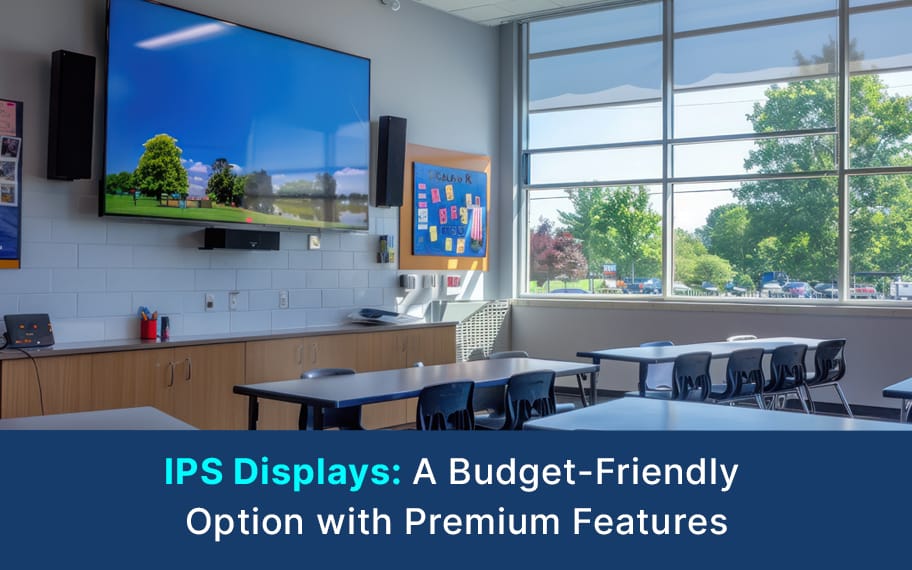IPS displays stand out as a budget-friendly yet premium option that offers exceptional performance and versatility. Whether you're outfitting a classroom, upgrading your home office setup, or enhancing your gaming experience, IPS displays provide stunning visuals and reliable performance without breaking the bank. Let's learn more about IPS display full form, and into what makes IPS displays a compelling choice and how they can be effectively utilized in educational settings.
What is an IPS Display full form?
IPS panel meaning (In-Plane Switching) is a type of LCD (Liquid Crystal Display) panel technology known for its superior color accuracy, wide viewing angles, and excellent image quality.
Unlike traditional TN (Twisted Nematic) panels, as the IPS display full form suggests, it maintains consistent colors and brightness levels even when viewed from different angles, making them ideal for applications where image fidelity is paramount. We also have an IPS monitor full form which is the same thing but popularly called a monitor.
Difference between VA panel and IPS panel
While IPS panel benefits are immense like excelling in color accuracy and viewing angles, VA (Vertical Alignment) panels prioritize contrast ratios and deep blacks. Here's a brief comparison:
- IPS Panel Benefits: Offers superior color accuracy, wide viewing angles, and consistent brightness levels across the screen. Ideal for tasks that require accurate color reproduction, such as graphic design, photo editing, and multimedia consumption.
- VA Panel Benefits: Provides high contrast ratios and deeper blacks, making it well-suited for applications like watching movies, gaming, and viewing content in low-light environments. However, VA panels may exhibit color shifting and limited viewing angles compared to IPS displays.
Those make up the basic difference between VA panel and IPS panel, as their meanings and functionalities.
7 Benefits of Using IPS Display
Here are seven compelling benefits of using IPS displays:
- Color Accuracy: IPS displays reproduce colors with exceptional accuracy, making them ideal for tasks that demand precise color representation, such as graphic design and photo editing.
- Wide Viewing Angles: IPS panels maintain consistent colors and brightness levels even when viewed from extreme angles, ensuring a uniform viewing experience for all users.
- Enhanced Productivity: The clarity and sharpness of IPS displays reduce eye strain and fatigue, allowing users to work comfortably for extended periods.
- Versatility: IPS panel meaning itself suggests they are suitable for a wide range of applications, including multimedia consumption, gaming, content creation, and professional use.
- Improved Gaming Experience: IPS panel benefits offer fast response times and minimal motion blur, enhancing the gaming experience by delivering smooth, fluid gameplay with vibrant visuals.
- Energy Efficiency: Many IPS monitor full form feature energy-saving technologies such as LED backlighting, resulting in lower power consumption and reduced operating costs.
- Longevity: IPS displays are known for their durability and longevity, ensuring reliable performance and longevity for years to come.
What is IPS panel in TV?
An IPS (In-Plane Switching) panel in a TV refers to a type of LCD (Liquid Crystal Display) technology known for its exceptional color accuracy and wide viewing angles. Unlike traditional TN (Twisted Nematic) panels, IPS panels ensure consistent colors and brightness levels even when viewed from extreme angles, making them ideal for applications where multiple viewers may be watching from different positions in the room. But still, what is IPS panel in TV as a functional thing? Well, IPS panels in TVs deliver vibrant and true-to-life colors, enhancing the viewing experience for movies, sports, and other multimedia content, while also reducing color distortion and image degradation.
How to use an IPS Display in a school?
In a school setting, IPS panel meaning changes slightly depending on why it is being used and under what circumstances can be utilized in various ways to enhance teaching and learning experiences. Keeping the difference between VA panel and IPS panel in mind, let's look at its uses:
- Interactive Learning: Use IPS displays as interactive whiteboards for engaging lessons and multimedia presentations.
- Digital Content Creation: Students can utilize IPS displays for digital art projects, video editing, and multimedia presentations, taking advantage of accurate color reproduction and wide viewing angles.
- Collaborative Projects: Facilitate collaborative learning by connecting multiple IPS displays for group projects and presentations.
- Virtual Field Trips: Take students on virtual field trips to museums, historical sites, and other educational destinations using IPS displays to display immersive multimedia content.
- Distance Learning: IPS displays enable seamless distance learning by providing high-quality video conferencing and screen-sharing capabilities, allowing teachers to connect with remote students effectively.
IPS displays offer a compelling combination of premium features, affordability, and versatility, making them an excellent choice for educational institutions seeking to enhance teaching and learning experiences. Whether used in classrooms, computer labs, or virtual learning environments, IPS monitor full form displays provide stunning visuals, consistent performance, and reliable durability, empowering students and educators alike to achieve their educational goals.
With Teachmint Interactive Flat Panels, Enhance the teaching and learning experience.




